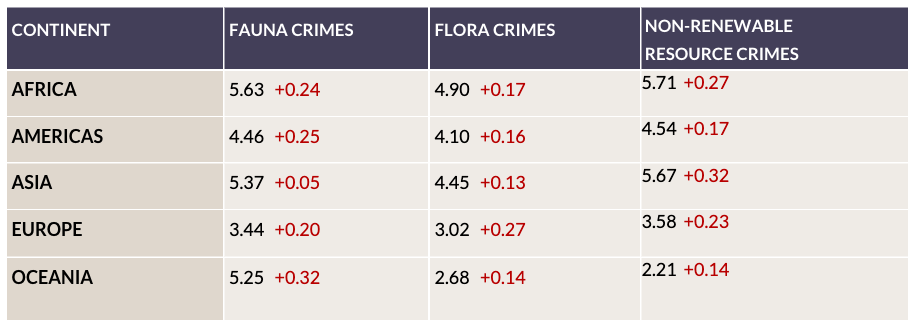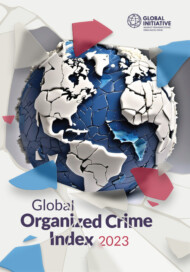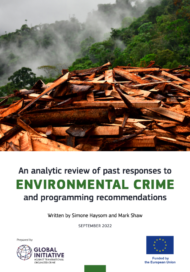Posted on 14 Mar 2024
In 2018, Australian photographer Adrian Steirn’s exposure of the illegal ivory trade in Zimbabwe, published through the Al Jazeera media network, prompted Zimbabwe to launch an investigation into the country’s former first lady, Grace Mugabe, for her alleged involvement in the smuggling of millions of dollars’ worth of ivory out of the country, including by ordering national park officials to release ivory from their stockpiles for gifts to first ladies in Asia. Supporting the research and reach of these exposés could be one of the keys to disrupting illicit environmental flows.
Organized environmental crime is on the rise globally, with significant impact on communities around the world. While 117 countries were found to have significant criminal markets in the trafficking and exploitation of fauna, flora or non-renewable resources, 36 countries – mainly in Africa, Asia and the Americas – stand out as having high levels of criminality in all three environmental crime markets assessed by the Global Initiative Against Transnational Organized Crime’s 2023 Global Organized Crime Index.
Environmental crime is largely facilitated and driven by state-embedded actors – which the Index found to be the most prevalent category of criminal actor on all three continents – often working in conjunction with foreign and private-sector partners. State-embedded criminals are particularly active in these markets because the state is often the gatekeeper to natural resources and those in positions of power may divert them for party funds or personal enrichment.
One driver of environmental crime is the perpetrators’ belief that their activities will not be exposed because of widespread corruption, which conceals their activities. High-level corruption and elite protection are not just a by-product of organized environmental crime, but act as drivers and enablers for the exploitation of wildlife, fisheries, forests and other natural resources. A lack of attention to and understanding of the social, economic and environmental impacts of these crimes exacerbate the problem.
Against this backdrop, reporting such as Steirn’s can play an instrumental role in raising the risks associated with environmental crime and exposing the wrongdoing of political, business and criminal elites.

Regional consultations organized as part of ECO-SOLVE, a global programme to disrupt illicit environmental flows, have found that exposés can help generate public outrage, demands for accountability or follow-up, such as formal investigations by national and international authorities. Media reporting was a critical component in triggering investigations into the notorious Gupta family in South Africa, accused of widespread corruption and bribery. Similarly, investigations by The Wall Street Journal and Sarawak Report served as a catalyst for formal investigations into the involvement of former Malaysian prime minister Najib Razak in a corruption scandal. There has also been a strong push for follow-up investigations after the release of the Panama and FinCen papers.
However, public information on elite protection, corruption and environmental crime is still scarce and there is a need for more data and information, not only on lower-level bribery but also on the people who profit from illicit trade and make the system work – the middlemen, lawyers and accountants who facilitate permits, move money and arrange logistics. AI-powered databases – such as actai.co, developed by an organization in Thailand combating corruption – might well be the crucial breakthrough. This database collects data on public procurement contracts and digitizes it to improve accessibility, providing the public with new research avenues. The use of open data platforms, coupled with targeted advocacy campaigns, can also create a sense of priority around organized environmental crime, particularly when exploitation takes place in remote areas receiving less attention from government and civil society actors.
Around the world, we are seeing fundamental changes in the information ecosystem and the way public data is used by government, private- and public-sector actors. This is being accelerated by the closing space for civil society to speak out and publish information on corruption and organized environmental crime – often accompanied by substantial safety and security risks for those who do so. According to the Committee to Project Journalists, 10 journalists were murdered in 2023 in direct retaliation for their published reporting or to kill a sensitive story they were working on.
Social media is further changing this ecosystem. While in some countries, such as in Myanmar, social media channels often remain one of the few platforms available to share information, misinformation and the increasingly difficult task of verifying and fact-checking sources have further undermined the public’s trust, allowing corrupt elites to more easily dismiss allegations.
Nevertheless, the investigations highlighted earlier are a reminder that exposure reporting can be a change agent. However, more needs to be done to understand what works and what does not, including the role of the languages in which information is available and published. For example, in South East Asia, access to information in local languages is key to raise awareness among communities, while foreign language material (particularly in English) is seen as essential to garner international support.
As organized environmental crime is a transnational issue, exposure reporting also requires international cooperation to track, identify and expose those who protect and profit from these criminal markets. Local and international media, as well as civil society organizations, all have different roles to play in exposing corruption: online news platforms are crucial for disseminating credible messages about elite corruption to local constituencies; global media houses can link cross-country investigations and raise awareness with international partners; and civil society can help understand and analyze patterns and typologies.
Al Jazeera’s ‘Gold Mafia’ investigation is a powerful example of cross-border cooperation and the use of undercover techniques to record elites confessing their crimes to people who appear to be accomplices. This investigative series on gold smuggling gangs in southern Africa revealed how criminals launder hundreds of millions of dollars. It highlights how exposing elite protection and corruption takes time and persistent effort from a diverse group of stakeholders, as well as messaging that is consistent, simple and adaptable to different audiences. While the impact of the series is yet to be determined, it also underscores the need to keep repeating messages, as the same information shared by different people can lead to more impactful results. While it is unlikely that exposure reporting alone can bring about systemic change, more attention needs to be paid to how journalists on the ground can be supported and protected, and how these partnerships can be strengthened to increase the impact of exposure reporting, and thus the risks and costs associated with elite protection and corruption in environmental crime.
This analysis is part of the ECO-SOLVE series of articles that aims to showcase solutions for monitoring and disrupting illicit environmental flows as well as strengthening international cooperation. ECO-SOLVE is a project implemented by the GI-TOC as part of the European Union’s Global Illicit Flows Programme.
Sign up to the ECO-SOLVE mailing list to receive regular updates about the project.



